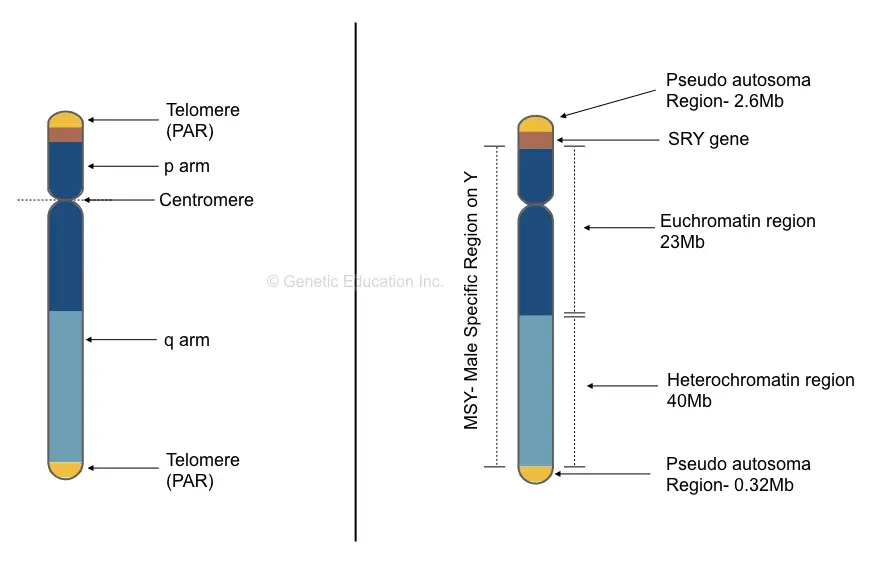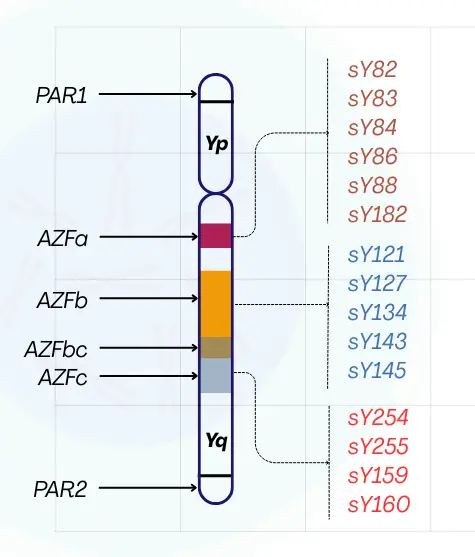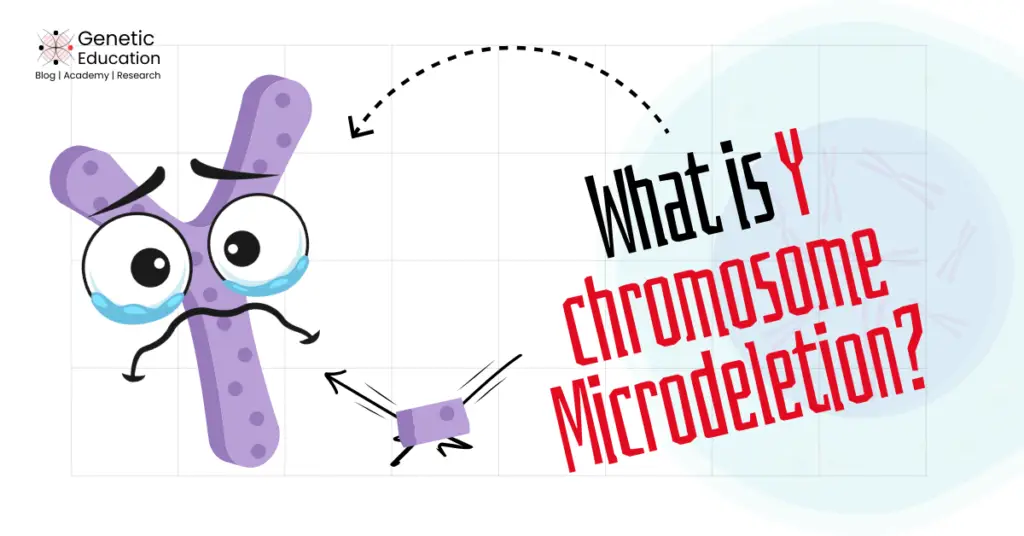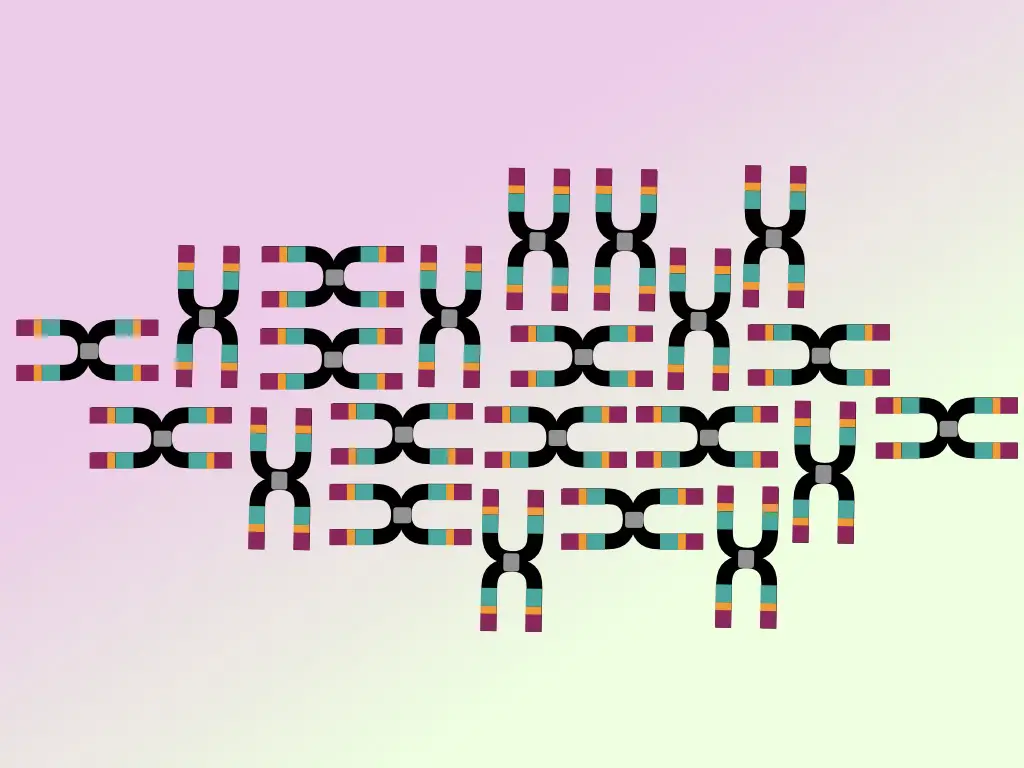“Y chromosome microdeletion is a genetic abnormality of the Y chromosome that usually results in infertility. Learn the concept, causes, and detection methods for Y chromosome microdeletion.”
Humans have 23 pairs of chromosomes, of which 22 are autosomes and a single pair is a sex chromosome. X and Y are the two sex chromosomes in humans, which play a crucial role in reproductive development.
Females have two X chromosomes while males have one X and one Y chromosome. Both X and Y chromosomes have several major differences.
Where the X chromosome plays a significant role in both males and females, the Y chromosome is only present in males and is involved in male primary and secondary sexual characteristic development.
The Y chromosome is one of the smallest chromosomes (about one-third of the size of the X chromosome) and yet one of the most difficult to understand.
Genes majorly present on the Y chromosome are directly or indirectly involved in the male sex differentiation and determination, and therefore primarily associated with fertility.
And henceforth, any alteration on the Y chromosome causes varied degrees of infertility in males. In this article, I will explain the second most common cause of male infertility– Y chromosome microdeletion (YCM).
We will explore the molecular mechanism behind the Y chromosome microdeletion and various detection methods that scientists use.
Stay tuned.
Disclaimer: The content presented herein has been compiled from reputable, peer-reviewed sources and is presented in an easy to understand manner for better comprehension. A complete list of sources is provided after the article for reference.
Key Topics:
What is the Y chromosome microdeletion?
Let’s start with the Y chromosome itself!

Normally, humans have one pair of sex chromosomes, either XX or XY. The Y chromosome is the sex-determining chromosome found only in males, along with the X chromosome.
Karyotype analysis showed that it is the smallest human chromosome with only 59 million base pairs, including 70 to 200 genes encoding several important proteins.
The SRY (Sex Determining Region on Y) gene is present on the Y chromosome and is considered the sex-determining gene. SRY is responsible for the development of a fetus into a male.
The detailed structure and function of the Y chromosome are explained in our previous article. You can click the link and read that article as well.
In addition, all the other genes on the Y chromosome are also important for male fertility. In conclusion, genes present on the Y chromosomes are either involved in spermatogenesis or male primary or secondary sexual characteristic development.
Henceforth, any abnormality either at a chromosomal, DNA, or gene level, on the Y chromosome results in a varied degree of infertility.
Y Chromosome Microdeletion and Infertility:
Globally, 15% of couples suffer from conceiving a pregnancy at a reproductive age, and in half of the cases, male factors are responsible. Globally, around 7% of males are affected by infertility.
One of the most commonly observed issues in male infertility is Y chromosome microdeletions.
In males, around 15% of infertility-related cases are due to microdeletions in the Y chromosome. Most microdeletions occur in the Y chromosome’s long arm (q arm).
Y chromosome microdeletion can occur randomly on the “q” arm. It loses genes that are involved in spermatogenesis.
Microdeletions in the Y chromosomes lead to the absence of several genes or sometimes one gene. These genes are important for making proteins that are involved in the development of sperm cells.
Two common types of associated conditions are azoospermia, the complete absence of sperm cells, and oligozoospermia, a low sperm count.
Either of the conditions can arise due to the deletion of several genes on three distinct Y chromosomal regions— AZFa, AZFb, and AZFc.
Azoospermia factors (AZF) on Y chromosome:
The long q arm of the Y chromosome contains the region known as Azoospermia Factor (AZF). This region contains the genes that are essential for spermatogenesis.
The AZF region is rich in palindromic and repeated sequences, which increase the chances of errors during DNA replication and recombination, leading to microdeletions.
The AZF region consists of three non-overlapping subdomains: AZFa, AZFb, and AZFc.

AZFa:
AZFa is 1.1 kb in size and consists of two important genes– USP9Y and DDX3Y. The reported deletion size within this region is 752 Kb and occurs due to homologous recombination between two types of sequences.
Although partial deletions are also reported, complete AZFa deletion causes azoospermia and Sertoli-cell-only syndrome. AZFa microdeletions account for 0.5 to 4% of total Y chromosome microdeletions.
AZFb:
AZFb is 6.2 Mb in size. The AZFb region of the Y chromosome is critical, as microdeletions in this region can result in the complete absence of sperm cells in the ejaculate.
This region contains the genes essential for meiotic progression (Defects can lead to spermatogenic arrest), sperm motility, and acrosome formation.
AZFb contains highly repetitive and palindromic sequences, which are prone to non-allelic homologous recombination.
Microdeletions in AZFb can lead to oligospermia and severe oligozoospermia. AZFb microdeletions account for 5 – 15% of all Y chromosome microdeletions.
AZFb contains two flanking markers (sY127 and sY134) that can be used in PCR-based microdeletion detection. AZFb contains several important genes, including RBMY1A1, PRY, HSFY1, and EIF1AY.
AZFb-c:
The AZFb-c region refers to the deletions that affect both the AZFb and AZFc regions. Notedly, the overlap between AZFb-c regions accounts for 15 to 20% of the total microdeletion.
The breakpoints of microdeletion cover two markers at a time, i.e., sY127 and sY254. Microdeletions here can affect some key genes such as DAZ, PRY, and BPY2.
Moreover, microdeletions in AZFb-c can cause the most severe spermatogenic failure among all the other Y chromosome microdeletion cases, as they can affect both meiotic and post-meiotic regulator genes.
AZFc:
AZFc is most frequently affected by microdeletions among all the AZF sub-domains. AZFc is 4.5 Mb in size, containing some essential genes for spermatogenesis such as DAZ, BPY2, and CDY1.
60-70% of all Y chromosome microdeletions are contributed by AZFc microdeletions. STS markers such as sY254 and sY255 can be used in PCR-based microdeletion detection for the AZFc region.
Microdeletions in AZFc can cause severe oligozoospermia and azoospermia. 30-40% of all microdeletions in AZFc are heritable.
The summary of each domain, its consequences and global prevalence are explained in the table below.
| AZF Region | Inheritance Pattern | Location on Y Chromosome | Consequences of Deletion | Global Prevalence |
| AZFa | Mostly de novo (rarely inherited) | Yq11.21 | Sertoli Cell-Only Syndrome (SCOS) – Azoospermia, no sperm retrievable. | 1-5% of YCM cases |
| AZFb | De novo (>90%) | Yq11.23 | Spermatogenic arrest – Azoospermia, failed sperm retrieval. | 5-15% of YCM cases |
| AZFc | Heritable (30-40% inherited) | Yq11.23 | Hypospermatogenesis – Oligozoospermia; sperm may be retrievable for ICSI. | 60-70% of YCM cases |
Causes of Y Chromosome Microdeletions:
Now, in this section, I will review several important mechanisms contributing to Y chromosome microdeletions.
Non-Allelic Homologous Recombination (NAHR):
Non-allelic homologous Recombination is a biological process in which two non-identical DNA sequences located at different genomic positions undergo recombination, resulting in genetic rearrangements such as duplication, deletion, and inversion.
NAHR occurs in genomic regions having high sequence similarity. This type of genetic rearrangement occurs during meiosis or mitosis, cell division.
AZFb and AZFc are highly prone to recombine with each other by non-allelic homologous recombination. Recombination between these two results in the Y chromosome microdeletions.
Palindromic Sequences:
The human Y chromosome is rich in repetitive and palindromic sequences. These palindromic sequences are likely to undergo self-recombination or intrachromosomal recombination.
Studies showed that the AZF region contains palindromic sequences, has a higher frequency of microdeletions.
Genetic Instability in AZF:
The highly repetitive nature of the AZF region also causes varied levels of genetic instability and results in varied degrees of microdeletions in this region.
Environmental Factors:
Many environmental factors can cause microdeletions. These factors include exposure to toxins, pollutants, and certain chemicals, oxidative stress, and infections.
Chemical compounds and physical factors present in the environment can affect the DNA in several ways, such as exposure to toxins and pollutants can lead to oxidative stress, leading to DNA damage.
Environmental factors either directly affect the DNA, leading to microdeletions, or sometimes interfere with spermatogenesis, resulting in poor sperm production, which can cause male infertility.
Although the role of environmental factors has been the least documented.
Y Chromosome Microdeletion Detection:
The Y chromosome microdeletions can be detected using conventional and qPCR, multiplex PCR, FISH, and next-generation sequencing.
However, gold-standard techniques like karyotyping or Sanger sequencing can not detect such microdeletions.
Conventional PCR:
PCR (Polymerase Chain Reaction) is a great option for studying sequence-level alterations. And hence, it is also a primary choice of technique for studying genetic rearrangements like microdeletions.
However, the setup is a bit different than the conventional PCR that we perform.
For the detection of microdeletions in the Y chromosome, STS markers, short for Sequence Tagged Sites, are used. These markers are short and unique DNA sequences whose location and sequence within the genome are known.
In the conventional PCR, STR markers’ specific primers have been designed and used for amplification. Each unique set of primers amplifies each marker from various regions.
For detection purposes, amplified PCR products are run on agarose gel electrophoresis. Known-sequence markers are then compared with the ladder to find our size difference.
The conventional PCR is the easiest way to detect microdeletions, but it has low throughput. Meaning, only a single marker at a time. Thus, it is a costly, labor-intensive, and time-consuming technique.
Multiplex PCR is the best alternative to native PCR.
Multiplex PCR:
Multiplex PCR has been the gold standard method in the diagnosis of the Y chromosome microdeletion. Here, instead of performing separate reactions for each marker, we prepare a single reaction for all the markers and amplify at a single annealing temperature.
The PCR reaction constituents remain the same, but in different concentrations and proportions, which we will discuss in a separate article.
Markers are run on the gel to analyze the results. Size differences and the absence or presence of marker-specific amplification bands are considered for results and interpretation.
Standardised protocols for multiplexing are now available, but it is still highly prone to non-specific amplification.
FISH:
Fluorescence in situ hybridization (FISH) is the least utilized molecular cytogenetic technique for detecting Y chromosome microdeletions.
FISH is a probe-based technique for detecting alterations in DNA sequences, which can detect microdeletions in patients with mosaicism.
Fluorescence probes specific to the AZF regions and/or DAZ, USP9Y, DBY, RBMY, and BPY2 are used for hybridization. The results are analyzed using fluorescence microscopy.
FISH is not a popular and widespread technique for Y chromosome microdeletion. The present technique is recommended if mosaicisms are suspected in patients with infertility.
It can detect the larger deletions easily, but may struggle to detect the smaller deletions.
For routine screening, Multiplex PCR can be more useful. This method is costly and labor-intensive.
Sequencing:
Due to the widespread use of the multiplex PCR in diagnosis, Sanger sequencing cannot be used for the detection of Y chromosome microdeletion in routine. However, it also has technical limitations dealing with such a type of genetic alteration.
A few recent studies employed Next-generation sequencing for Y chromosome microdeletion. NGS is a powerful high-throughput sequencing approach that can detect any alterations in the whole genome or chromosome.
However, it is a costly, labor-intensive, and time-consuming process.
Related article: What if the Y Chromosome Completely Vanished From Earth?
Wrapping Up:
Y chromosome microdeletion is a global male infertility concern with a significant number of cases.
Among all the suggested and used techniques in the literature, the multiplex PCR (either simple or quantitative) has been extensively applied for Y chromosome microdeletion detection.
Scientists are also looking for gene therapy approaches to treat the microdeletion. But it’s in the research phase now!
In the next article, I will give you a complete technical guide to perform multiplex PCR for Y chromosome microdeletion detection.
I hope you like this article. Do subscribe to Genetic Education for more informational content.
References:
- Skaletsky, H., et al. (2003). The male-specific region of the human Y chromosome is a mosaic of discrete sequence classes. Nature, 423(6942), 825-837. https://doi.org/10.1038/nature01722.
- Hughes, J. F., & Page, D. C. (2015). The biology and evolution of mammalian Y chromosomes. Annual Review of Genetics, 49, 507-527. https://doi.org/10.1146/annurev-genet-112414-055311.
- Krausz, C., et al. (2014). ESHRE consensus guidelines on diagnosis and management of Y chromosome microdeletions. Human Reproduction, 29(5), 873-887. https://doi.org/10.1093/humrep/deu023.
- Navarro-Costa, P., et al. (2016). The Y chromosome-Beyond gender determination. Fertility and Sterility, 106(1), 9-18. https://doi.org/10.1016/j.fertnstert.2016.04.036.
- Vogt, P. H., et al. (2019). Human Y chromosome microdeletions and their implications in male infertility. Journal of Endocrinological Investigation, 42(9), 1019-1030. https://doi.org/10.1007/s40618-019-01022-9.
- Repping, S., et al. (2002). High mutation rates have driven extensive structural polymorphism among human Y chromosomes. Nature Genetics, 32(2), 360-364. https://doi.org/10.1038/ng1003.
- Simoni, M., et al. (2008). Molecular diagnosis of Y chromosome microdeletions in Europe. International Journal of Andrology, 31(4), 377-387. https://doi.org/10.1111/j.1365-2605.2008.00880.x.
- Colaco, S., & Modi, D. (2018). Genetics of the human Y chromosome and its association with male infertility. Reproductive Biology and Endocrinology, 16(1), 14. https://doi.org/10.1186/s12958-018-0330-5.
- Oates, R. D., et al. (2017). Clinical and diagnostic features of patients with Y chromosome microdeletions. Fertility and Sterility, 108(3), e47. https://doi.org/10.1016/j.fertnstert.2017.07.149.
- Practice Committee of ASRM (2020). Management of non-obstructive azoospermia: A committee opinion. Fertility and Sterility, 114(3), 465-473. https://doi.org/10.1016/j.fertnstert.2020.06.043.
- Dondorp, W., et al. (2015). ESHRE position statement on screening for Y chromosome microdeletions. Human Reproduction, 30(5), 1265-1267. https://doi.org/10.1093/humrep/dev053.
- Hanna, E., & Gough, B. (2020). The impact of infertility on men’s mental health. Journal of Reproductive and Infant Psychology, 38(3), 223-235. https://doi.org/10.1080/02646838.2019.1636902.
- WHO Manual (2021). WHO Laboratory Manual for the Examination and Processing of Human Semen (6th ed.).


